
Coryphantha difficilis Photo by: Amante Darmanin
Blooming habit at San Vicente, Tamaulipas, Mexico.
Origin and Habitat: Coryphantha difficilisSN|10249]]SN|10197]] grows in the Mexican state of Coahuila in the area around the Sierra de la Paila in Coahuila State (Hipolito, La Paila, La Rosa, El Sacrificio, Casas Coloradas, Las Imagines, Las Palomas, Parrial de la Paila, Zona de Minas, Mount Paila, Saltillo, Laguna de Meyran, San Ildefonso, San Jose de la Paila, Estacion Marte, Sierra los Alamitos and adjacent localities). There are supposedly reports of the species from the United States (Texas and Arizona) that require confirmation. Although this species has a more restricted range than other species, the extent of occurrence is still well over 20,000 km². Subpopulations are fairly scattered, but it is common where it occurs.
Altitude range: 1000-1750 metres above sea level.
Habitat and Ecology: This cactus grows as solitary plants in shrubland on alluvial plains and in limestone gravel on the slopes of the Sierra Paila. Accompanying cactus and succulent species can be Mammillaria chicaSN|15974]]SN|25133]], Mammillaria grusoniiSN|25133]]SN|15974]], Opuntia imbricataSN|8157]]SN|8157]], Epithelantha micromerisSN|6936]]SN|6936]] v. gregii, Hamatocactus hamatacanthus, Coryphantha validaSN|10197]]SN|10249]], Ariocarpus kotschoubeyanusSN|2127]]SN|2127]]. There are no major threats, although some subpopulations are declining due to trampling by goats.
Synonyms:
Description: Coryphantha difficills (difficult pincushion) is a globose long-lived cactus species that only starts reproducing after 15 years. Although this species may be grown in specialist collections it is not widely sought after as an ornamental. It is recorded as being difficult to maintain in cultivation in Europe. The 2 cm long, curved spines range from white to rust red, have red tips, and do not conceal the stem. When this cactus is active and growing in the summer, the crown of the plant appears to be covered in wool. The shiny, yellow flowers are over 4 c) in diameter and attract attention. Generally, it does not offset into clusters
Stem: Mostly solitary, spherical to short cylindrical flat or slightly depressed on the top, white-woolly, bluish-grey-green to dull green, up to 8-14 cm tall, 5-8 cm in diameter.
Roots: Fibrous.
Tubercles: In 8 and 13 series, flattened broad-conical, appressed, oblique and their outer end points outwards, upper surface grooved. Axils white-woolly.
Areoles: Round, 3 mm diameter, white-woolly in youth.
Central spines: 0-4(-6) , the three lower ones spreading, porrect, curved downwards, strong, subulate, the upper one slightly curved, protruding, thinner, all 16-20 mm long, in new growth brown, darker towards the tips, later turning grey from the base.
Radial spines: 12 to 14(-20) , lower and lateral 6-9 strongest and shortest, subulate, straight, radiating and horizon-tally arranged, 8-10 mm long, the upper 7-10 in a bundle, firm, needle-like, straight, up to 2 cm long ( Similarly to Coryphantha salinensisSN|10432]]SN|10043]] two types of radial spines can be differentiated: lower, stiff, regularly radiating, often only 10 mm long spines and upper, longer (up to 20 mm) often bundled spines.)
Flowers: The flowers are large, funnel-shaped, 6-8 cm diameter, purely yellow, without any red in the throat. Filaments shiny yellow, anthers yellowish, stigma yellowish with 7-8 whitish lobes.
Fruit (berry): Roundish, green, juicy 18 mm long, 14 mm diameter with attached flower remnants.
Seeds: Reniform, brown with reticulate testa, 1.5 mm long, 0.9 mm wide
Remarks: This species is somehow variable in habitat and intergrades and is sympatric with Coryphantha salinensisSN|10432]]SN|10043]]. Coryphantha densispinaSN|14676]]SN|14676]] Werdermann in Fedde, Rep. 30:57, 1932 has been allocated to Coryphantha werdermanniiSN|10043]]SN|10432]] by several authors. Hence, the described tubercle form and size correspond to Coryphantha. The name-giving density of spination is reminiscent of Coryphantha werdermanniiSN|10043]]SN|10432]], but is also well-known in Coryphantha difficilis from locations at higher sealevels.
Bibliography: Major references and further lectures
1) Gómez-Hinostrosa, C., Hernández, H.M., Lüthy, A.D. & Dicht, R.F. 2013. Coryphantha difficilis. The IUCN Red List of Threatened Species. Version 2015.2. <www.iucnredlist.org>. Downloaded on 19 July 2015.
2) David Hunt, Nigel Taylor “The New Cactus Lexicon” DH Books, 2006
3) James Cullen, Sabina G. Knees, H. Suzanne Cubey “The European Garden Flora Flowering Plants: A Manual for the Identification of Plants Cultivated in Europe, Both Out-of-Doors and Under Glass”Cambridge University Press, 11/August/2011
4) Edward F. Anderson “The Cactus Family” Timber Press, 2001
5) Reto Dicht, Adrian Lüthy "Coryphantha: Cacti of Mexico and Southern USA" Springer Science & Business Media, 14 March 2006.
6) Leo J. Chance "Cacti and Succulents for Cold Climates: 274 Outstanding Species for Challenging Conditions" Timber Press, 19 June 2012
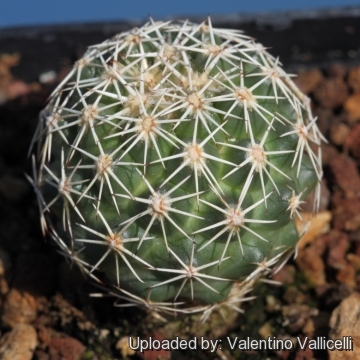 Juvenile specimen (La Paloma, Coahuila) Photo by: Valentino Vallicelli
Juvenile specimen (La Paloma, Coahuila) Photo by: Valentino Vallicelli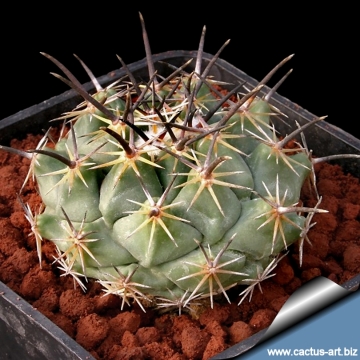 - This is a very rare strongly spined species Stems are bluish-grey green. Very Beautiful. Photo by: Cactus Art
- This is a very rare strongly spined species Stems are bluish-grey green. Very Beautiful. Photo by: Cactus Art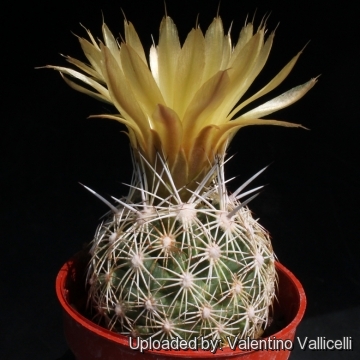 Coryphantha difficilis Photo by: Valentino Vallicelli
Coryphantha difficilis Photo by: Valentino Vallicelli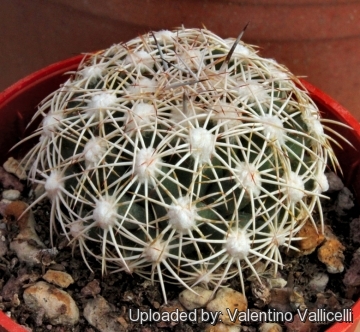 El Pilar, Coahuila. Photo by: Valentino Vallicelli
El Pilar, Coahuila. Photo by: Valentino Vallicelli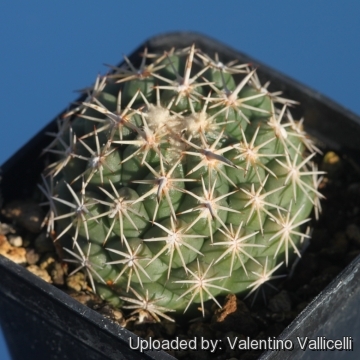 - This is a very rare strongly spined, but very slow growing species. Stems are bluish-grey green. Very Beautiful. Photo by: Valentino Vallicelli
- This is a very rare strongly spined, but very slow growing species. Stems are bluish-grey green. Very Beautiful. Photo by: Valentino Vallicelli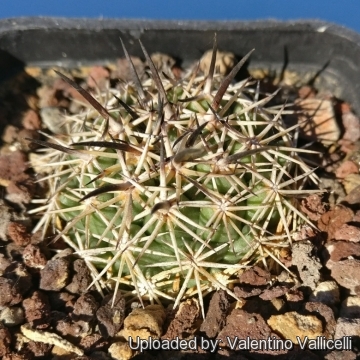 Coryphantha difficilis El Pilar Photo by: Valentino Vallicelli
Coryphantha difficilis El Pilar Photo by: Valentino VallicelliCultivation and Propagation: In culture, contrary to its name "difficilis" (difficult) this species does not show special problems, but it is very slow-growing. In Coryphantha difficilisSN|10197]]SN|10197]] the observation of the plant development from radial spined youth-forms to the definite, wildly spined outlook is particularly interesting.

















